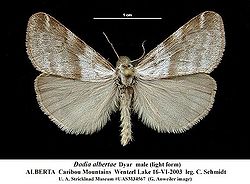Tiger moth
| Tiger moth |
|---|

|
| Scientific Classification |
|
| Subfamilies |
Anatomy
The larvae of the more common species are very distinctive in appearance, being quite hairy, with four conspicuous tufts of hair on the top of the body toward the head. These hairs are easily dislodged and can cause a skin reaction or allergy. The larvae of the tussock moths feed on the foliage of forest and shade trees and sometimes reach injurious proportions. There are several native species in this family, but the most notorious species, the gypsy moth (Lymantria dispar), is an import from Europe and has become a serious pest of forest trees in the northeastern United States. The antennae of the male tussock moth are quite feathery. Other than this, the males are of typical moth form and usually mottled in coloration.
Reproduction
the reproductive biology of the arctiid moths creatonotos transiens and C.gangis exhibits a novel ontogenetic phenimenon morphogenesis of male coremata size being directly controlled by the quanity of hostplant derived pyrrolizidine alkaloids larvae.in addition, the same alkaloids directly control the quanity of male phermones sythesized and available for deploying these scent organs. reproduction in these insects thus shows striking linkages between ecological,behavioural, chemical and morphological features.
Ecology
Moths of the family Arctiidae, with their brilliant coloration, spectacular courtship rituals, and bizarre defenses, are wonders of the natural world. Tiger Moths and Woolly Bears, the first book written about this fascinating group, documents how the adults and larvae of the Arctiidae flourish in a world rife with predators, parasites, and competitors. The contributing authors -- each a recognized expert in the field -- weave together seminal studies on this family's phylogeny and behavior, natural history, chemical communication, mate choice and sexual selection, adaptive coloration, speciation, and more.
Other
Tiger moths are some of the more familiar moths because of their bright colors and beautiful patterns. Some brightly colored species fly during the day and are commonly mistaken for butterflies. The caterpillars of tiger moths are called woolly bears. They are large and evenly fuzzy, and may be black, brown, or yellow and black. Although all caterpillars of this family are called woolly bears, only one species, Isia isabella, is called the Woolly Bear Caterpillar Moth.
Gallery
References
- Arctiinae by Wikispecies.
- http://cat.inist.fr/?aModele=afficheN&cpsidt=3764063
- [http://http://www3.interscience.wiley.com/user/accessdenied?ID=120151406&Code=4717&Page=http://www3.interscience.wiley.com/journal/120151406/references




